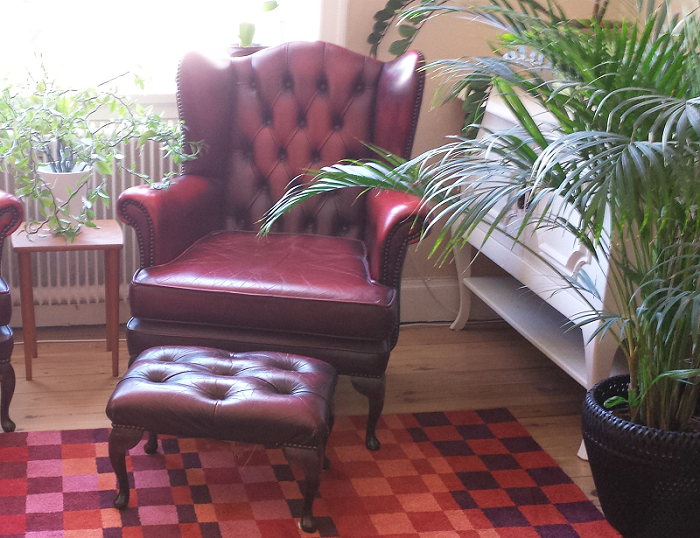
Picture yourself on a deserted beach, eyes closed and just listening. It’s a windy day in September. Seagulls circle around a rock formation, the waves break up into foam. It starts to rain, so you record a sound snippet on your cell phone for later. You consider playing the clip on your car stereo, but you don’t, because you know it just isn’t the same thing. Besides the breeze and the ocean smell, what’s the difference? Let’s talk room acoustics.
“But it sounded great in the store?!”
We will begin our room acoustics discussion with a trip to the hi-fi store.
The clerk eagerly whisks you into the inner sanctum of his shop: “the Grotto”. Damped lights, walls covered with felt, and a leather couch right at the center. This is where he showcases his most exclusive equipment. You’ve had your eyes on a sleek, piano-black surround system for a while now, and you’re anxious to hear it.
As the clerk grins and turns the volume knob, he knows it’s music to your ears. Strong, yet contained bass, incredibly well-defined middle range, and crisp, airy highs. Sold!
Now, placed in its newfound home — your sparsely decorated living room — your perfect buy somehow seems to have lost its shine. The vocals come off as shrill; the lower frequencies uncontrolled, as if literally bouncing between the tiled floor, the half-empty aluminum bookcase, and the bay window.
Are you experiencing a case of buyer’s remorse? Did the speakers take a hit on the way home? Or could it possibly be that your living room isn’t up for the task?
About Room Acoustics
Room acoustics deals with how large enclosures — rooms, offices, cinemas, industrial halls, etc. — interact with and affect sound. The ambition is often to characterize the room over the entire audible frequency range. The challenges and methods used depend on the frequencies and the size of the room.

The Sibelius Hall in Lahti, Finland is renowned for its acoustics.
Bass
The bass range is characterized by modal behavior, with certain discrete frequencies being amplified. They correspond to resonances in the room. For example, in an empty 4-by-5-by-2.5 meter living room, the fundamental eigenfrequency is 34 Hz, and there are further resonances at 43 Hz and 55 Hz. At 69 Hz, a second order length mode coincides with the first height mode, causing a potentially strong amplification of tones near this frequency.
Unless you tear down the walls, it is hard to get a completely uniform response over the bass frequencies. You can avoid the strongest resonances by making sure that the room dimensions are not multiples of each other. You can make the peaks and dips less pronounced by using absorbing wood panels, for example, or professional-grade bass trap panels.
Midrange
As you move up to high bass and midrange frequencies, the modes appear at denser and denser intervals. Because they all have their own pattern of nodes and antinodes, your speakers will excite some more than others. The listening position also affects what sound you will hear. The situation is quite complex, but can be well-analyzed by a full-wave pressure acoustics simulation. See, for example, the beautiful model in Fanny’s post on acoustics and interior design from last November (scroll down to the section on analyzing eigenmodes of a room).
The damping properties of the walls and the furniture determine the width of the resonances. At some point, typically a few hundred Hz for a living room, the average distance between the resonances will become less than their width. This marks the transition to the high frequency range, in which the room’s response to sound is more uniform.
Treble
At high frequencies, it is useful to look at the sound as rays from the loudspeaker to the listening position. The most powerful rays are those that travel straight from the speaker to you, but you will also be hit by rays being reflected once or a few times off the walls, ceiling, or floor. The total intensity of these so-called early reflections will depend on the frequency, the geometry of the room, and the surface materials.
Ray acoustics is a computational method that traces the acoustic rays as they travel across your room and interact with the various surfaces. It helps you characterize the high-frequency acoustic performance of the room, and can be used for finding its reverberation time. Detailed impulse response calculations are also possible.
With each reflection, the sound spreads out a little, behaving slightly less like a ray and slightly more like a diffuse field. Acoustic diffusers are designed to maximize this effect, reducing direct reflections while keeping the acoustic energy within the room.
In large halls and with sound sources that are spread out, solving the acoustic diffusion equation can yield faster and better results than ray acoustics. While lacking information on local phase, direct sound, and early reflections, it can still give you an effective assessment of the sound pressure level distribution in the room.
Liven up Your Living Room
So how do you make your living room sound more like “the Grotto”? It depends, of course, a lot on what you start out with.

The author’s living room windows could use some curtains.
If it is anywhere near as minimalistic as the one I described above, challenging your esthetic preferences and introducing some clutter can go a long way. A soft, absorbing carpet will take the sharpest edges off the high frequencies. Filling your bookcase with literature of various sizes can make it a decent diffuser. Throw in some padded furniture, drape the windows, and sprinkle some bric-a-brac across the room.
You will never want to turn off the music!




Comments (0)